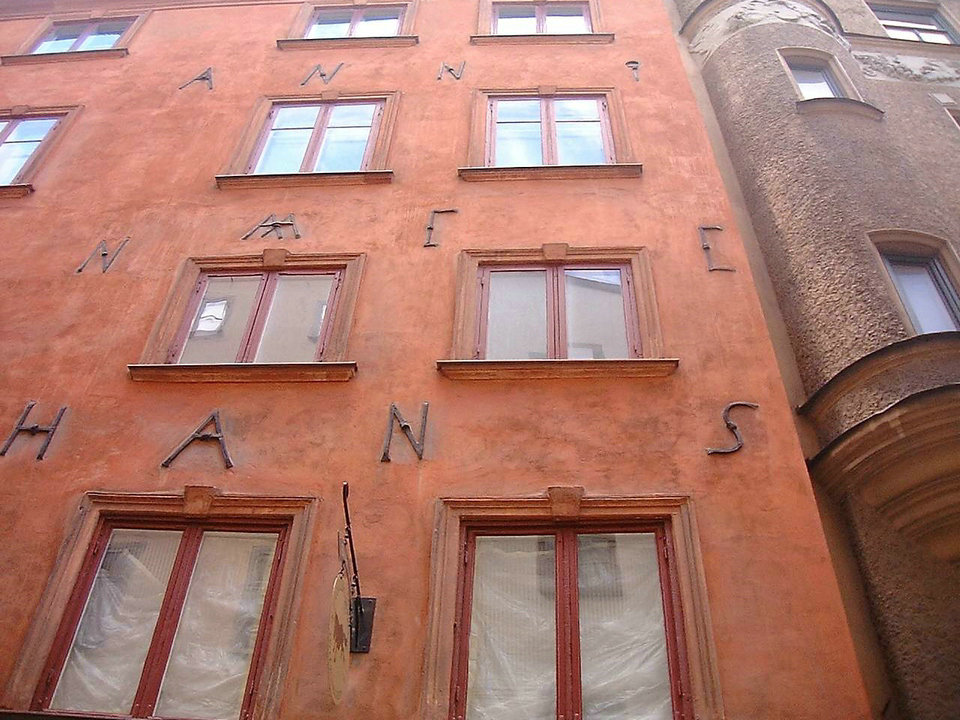Anchor plate


An anchor plate or wall washer is a large plate or washer connected to a tie rod or bolt. Anchor plates are used on exterior walls of masonry buildings, for structural reinforcement. Being visible, many anchor plates are made in a style that is decorative.
One popular style is the star anchor — an anchor plate cast or wrought in the shape of a five-pointed star. Other names and styles of anchor plate include earthquake washer, triangular washer, S-iron, and T-head. In the United Kingdom, pattress plate is the term for circular restraints, tie bar being an alternate term for rectangular restraints.
Anchor plates are made of cast iron, sometimes wrought iron or steel, and are often used on brick or other masonry-based buildings. They are commonly found in many older cities towns and villages in Europe and in more recent cities with substantial legacies of 18th- and 19th-century brick construction, such as New York, Philadelphia, St. Louis, Cincinnati and Charleston, South Carolina, and in older earthquake prone cities such as San Francisco, as well as across all of Europe. The tie-rod-and-plate assembly braces the masonry wall against lateral bowing.
Definition
According to the Oxford Dictionary of Construction, Surveying and Civil Engineering, an anchor plate “is a plate attached to a component that enables other components to be connected to it.”
Although there are many types of anchors or anchorages, according to the Dictionary of Architecture and Construction, an anchor plate specifically is a “wrought-iron clamp, of Flemish origin, on the exterior side of a brick building wall that is connected to the opposite wall by a steel tie-rod to prevent the two walls from spreading apart; these clamps were often in the shape of numerals indicating the year of construction, or letters representing the owner’s initials, or were simply fanciful designs.”
While most types of anchors are made of only steel, anchor plates might also contain malleable or cast iron. The exterior wall washer is most often made of a cast-iron star or a flat steel plate.
History of use and studies
During the Roman Empire, wooden tie-beams (or tie rods)were used between arches to negate the outward horizontal forces between them.
In the modern era, tie-rods are made of iron or steel, and serve to reinforce vaults, arches, and in general masonry structures. Masonry walls are strengthened through a tie-rod that connects between parallel walls at the floor-level, which creates a horizontal compression state, thereby increasing the wall’s shear strength. While the current literature is very poor, some studies have been done on analysis of anchor plates and tie-rods, for example one study dealing with concrete panels, which, although a thin veneer, may also need anchor plates to help stabilize the wall.
The pressure that an anchor plate provides is constantly stiff; however, there appears to be a limit of useful anchor plate widths. That is, a study found that widths greater than 100 mm the advantage of having a wider plate decreased, meaning that there is a threshold for optimal function of the anchor plate.
Tie rod for arches and vaults
Tie rods, drawstrings or anchor beams are used to absorb the thrust of arches and vaults. Tie rods were also installed as temporary vault securing and then removed after all the stiffening walls had been completed and hardened by mortar hardening (evidenced in Chartres Cathedral and Westminster Abbey). In other constructions, the tie rods were left to secure the vaults under construction. This was common, especially in brick buildings. Also wooden beams were used in combination with flat iron and iron splints as tie rods (see wall anchor).
The anchor beam of a roof truss secures the longitudinal walls against the thrust of the rafters by connecting the two rafters (the rafters) into a frictional triangle, the roof truss. In a purlin roof, the foot purlins on which the rafters rest are usually connected by the floor joists.
Gable anchor
If a gable wall is not secured against tipping by transverse walls, it must be connected via gable anchors to the roof of the throats or the middle and ridge pillars of the roof truss. Since the beam layer runs parallel to the gable, the gable anchor should be connected to at least two other beams in addition to the stringing bar. The roof truss itself is stiffened by headbands or Windrispen in the longitudinal direction.
ring beam
A ring anchor is a ring-shaped closed component made of wood, iron or reinforced concrete, which is intended to prevent falling apart of the enclosed components. A ring anchor is usually embedded in masonry in all outer walls below the ceiling level surrounding the masonry. Its actual shape therefore corresponds to the contour of the building and actually only describes a circular ring in domed buildings. Especially in domes and monastery vaults, the (vault) thrust introduced into the perimeter walls is easiest to pick up with a ring anchor. If ring anchors are assembled from individual components, they must be connected to one another with high tensile strength.
Strand
Strand anchors are used in rock construction and embankment protection. They generally consist of a wire rope with seven strands (single wires) of high-tensile steel. They are inserted into a borehole and fixed with cement mortar or synthetic resin. The outer end is tensioned at the borehole mouth with tensioning devices and fixed with wedges and anchor plates. Alternatively, a bar anchor can be used.
Cavity wall ties
Air-layer anchors are used for anchoring the front wall shell in double-skin exterior walls and today are usually made of stainless steel. Previously, galvanized or plain steel was also used or some bricks were walled across to bridge the layer of air.
Source From Wikipedia